#Spuyten Duyvil Library
Explore tagged Tumblr posts
Text
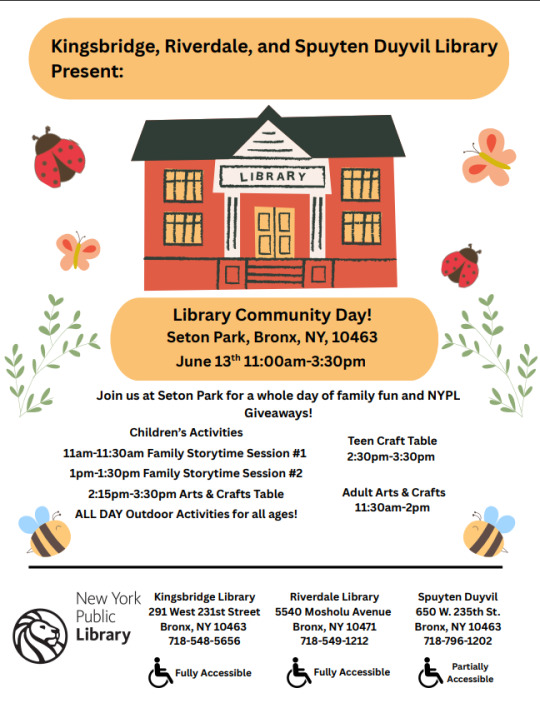
Join the Kingsbridge, Riverdale and Spuyten Duyvil libraries as they host activities for the whole family during this special all day event at Seton Park. Enjoy storytime @ 11am & 1pm, plus arts & crafts activities and lawn games throughout the day! Get to know your neighborhood libraries during this fun-filled affair!
Library Community Fun Day
Seton Park (next to the Spuyten Duyvil Library)
Friday June 13, 2025
11:00am - 3:30pm
#children's programs#teen programs#adult programs#arts & crafts#storytime#library events#Kingsbridge Library#Spuyten Duyvil Library#Riverdale Library
4 notes
·
View notes
Text

David Cieri & Valery Oisteanu in a new performance at Jefferson Market Library: "Here, There & Nowhere"
New poetry book soon to be released in Spuyten Duyvil
28 September 6-8pm Avantgarde avant-premier
2 notes
·
View notes
Text
Places in New York City that don't look like they're in NYC (and aren't in Central Park*)
Forest Hills Gardens, Queens
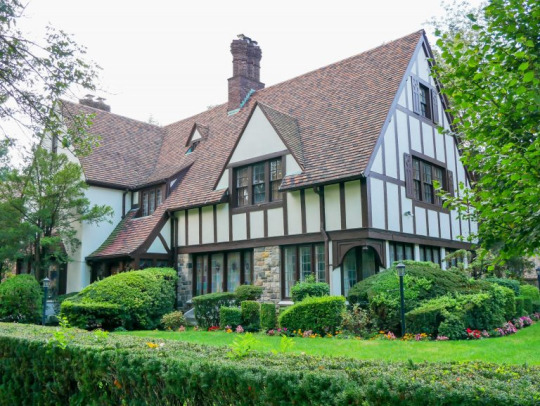
This lovely NYC neighborhood was modeled after an English village back when it was first built in 1910, offering a little piece of the UK in Queens, with quaint Tudor-style houses and a town center with a train station. Read more about it here.
Where: 71st Ave, Forest Hills, NY
The Met Cloisters, Washington Heights
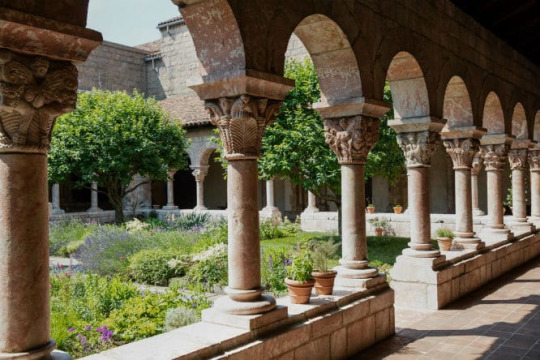
If you didn’t know about The Cloisters before, you might not ever believe that a medieval castle was in the middle of New York City. But it is! The Cloisters is a branch of The Metropolitan Museum of Art that is devoted to European art history. It was designed and constructed taking elements from many different medieval cloisters, which are covered pathways in a church or monastery that connect to form an open square in the center. Find out more here.
Where: 99 Margaret Corbin Drive
Hours: Thursday-Tuesday 10 a.m. – 5 p.m., Closed Wednesdays
Purchase tickets on their website here.
Villa Charlotte Bronte, The Bronx
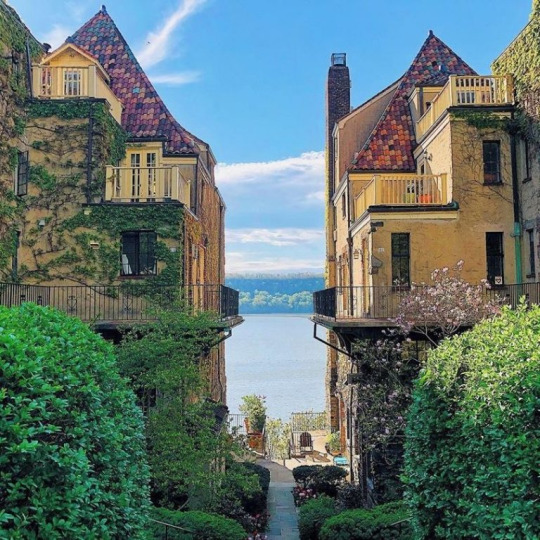
Italy or the Bronx? The beautiful “Villa Charlotte Bronte” apartments look straight out of Europe. They were built in 1926 and sit along the Palisades, overlooking the Hudson River, in the Spuyten Duyvil neighborhood of The Bronx. The design was actually based on an Italian villa, which definitely makes sense, and includes balconies as well as lush gardens!
Where: 2501 Palisade Ave, The Bronx
Fort Tryon Park, Inwood
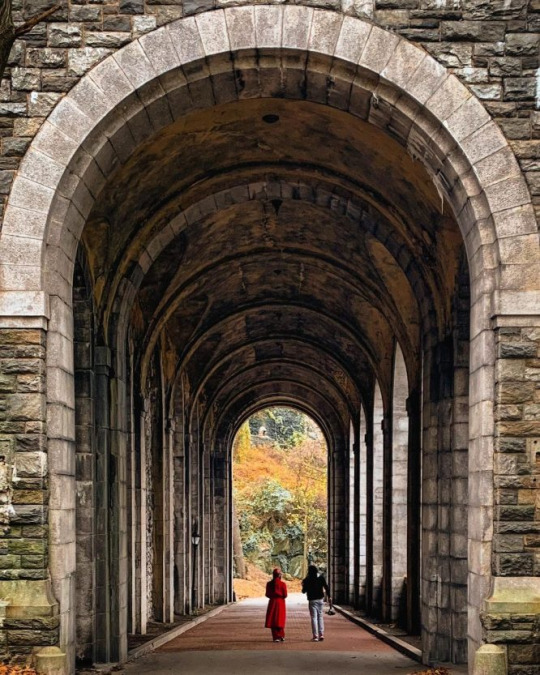
These massive stone arches looks straight out of another era…and that’s because they are! Built between 1901 and 1905, the “Billings Arcade” is some of the last remains of the Tryon Hall mansion, built by wealthy Chicago industrialist Cornelius K. G. Billings. John D. Rockefeller, Jr. purchased the $2 million estate in 1917, only for it to burn down a few years later. Read more about the history from the Fort Tryon Park Trust.
Makes sense that #2 on our list is right next door!
Where: Riverside Dr. To Broadway (arches are near down toward the Billings Lawn, this website has good detailed directions)
Hours: Open daily, 6 a.m. – 1 a.m.
Greenacre Park, Midtown

This hidden little park in Midtown East is only 1/7 of an acre, but it definitely packs a punch. It holds a 25-foot waterfall that is not only a sight for sore eyes in the middle of Manhattan, and will also distract from the noise of the busy streets. It was built in 1971 by the Greenacre Foundation from a design by Hideo Sasaki.
Where: 217 E 51st St.
Hours: Open daily, 8 a.m. – 6 p.m. *Reopens for the season Monday, April 3*
Bonus: Here’s our list of other stunning secret gardens hidden in NYC
Andrew Carnegie Mansion, Upper East Side
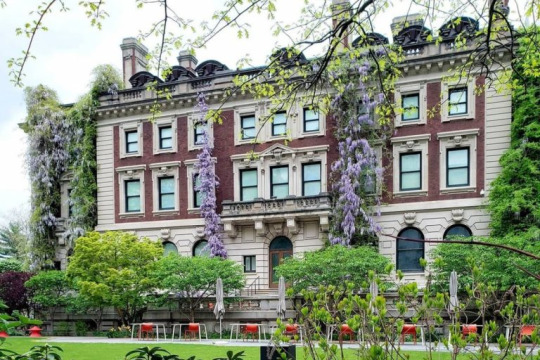
The Andrew Carnegie Mansion is a historical spot now home to the Cooper Hewitt Smithsonian Design Museum. The mansion was originally completed in 1902 and reached landmark status in 1974, though it has undergone much change over the years. The grounds of the mansion, and now museum, feature an expansive garden and cafe for visitors to enjoy as well as a little opulent oasis in the middle of Manhattan.
Where: 2 E. 91st Street
Hours: Thursday–Monday, 9 a.m. – 5 p.m.
Morgan Library, Murray Hill

The Morgan Library feels like a trip to a library from Harry Potter or old world Europe. The historical venue was built as a private library between 1902 and 1906 for financier Pierpont Morgan. He began collecting manuscripts and other historical materials as early as 1890, and now they line the walls of the museum. You can find some of the country’s rarest music manuscripts, early children’s books, Americana, early printed books and more there. Purchase tickets here.
Where: 225 Madison Ave
Hours: Varies, see website for more info
“Little Paris,” Nolita/SoHo
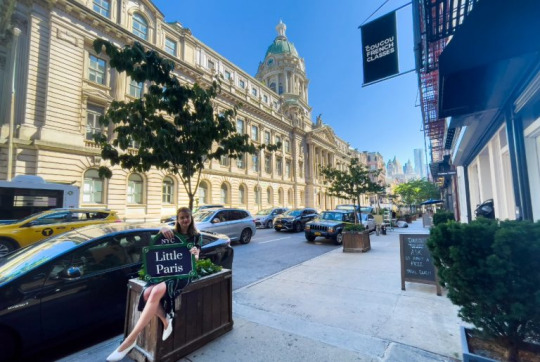
NYC’s own “Little Paris” is the work of one group of French business owners determined to showcase NYC’s own enclave of French culture on Centre Street in Nolita/SoHo (between Broome & Grand St.). Along Centre St. you can find French café and bakery Maman, wine bar La Compagnie des Vins Surnaturels, and art and home decor shop Clic. To complete the Parisian vibe is the old police headquarters located across the street from Coucou French Classes, whose architecture was inspired by Paris’s famous Hotel de Ville (City Hall) with its Beaux Arts style. Read more about it here.
Where: Centre Street between Broome & Grand St.https://www.tiktok.com/embed/v2/7107213381651795246
Van Cortlandt House, The Bronx
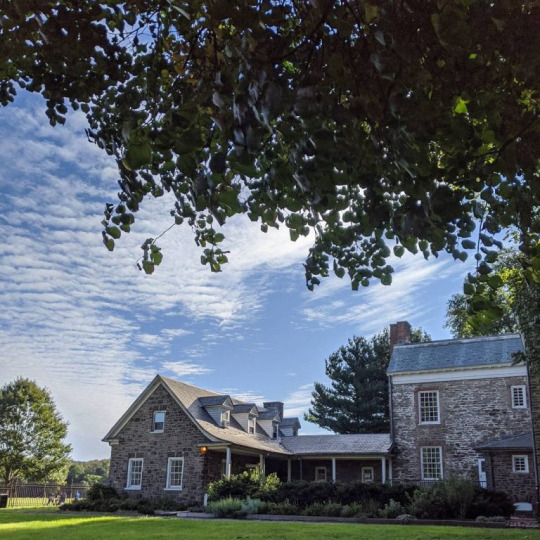
The Van Cortlandt House is the oldest surviving building in The Bronx, and was built by Frederick Van Cortlandt (1699 – 1749) in 1748. The Van Cortlandts were a prominent merchant family who owned a plantation on the property. Generations of the family lived there for 140 years, and in 1887 it was sold to the City of New York and made into public park land (Van Cortlandt Park itself it also the third largest park in NYC and has lots of unique hiking trails and vantage points!). Before it was a museum it had many random, unique uses like a temporary police precinct and a living space for ranch hands that cared for a herd of buffalo on the property.
Where: 6036 Broadway, Van Cortlandt Park
Hours: Varies, see website for more info
Stone Street, Financial District
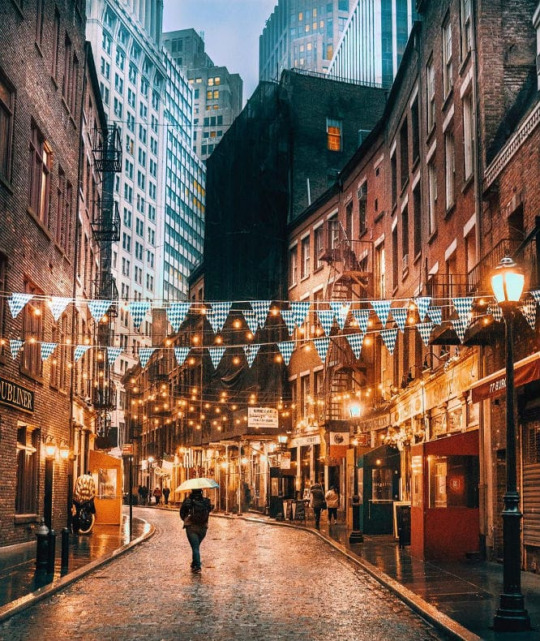
Stone Street is one of the rare cobblestone streets in NYC, that gives more of an old school European feel to the starkly modern city buildings around it. According to Untapped Cities, the street was one of the first to be paved with cobblestones (in 1658) in the Nieuw Amsterdam colony, which is where it got its name. Today, no cars are allowed through and in the warm weather because of outdoor seating, it’s one of the few NYC locations where drinking is actually allowed in the streets.
Where: From Whitehall St. to Broad St., between Marketfield St. and Bridge St.
Hours: Open 24 hours
Ford Foundation Garden, Midtown
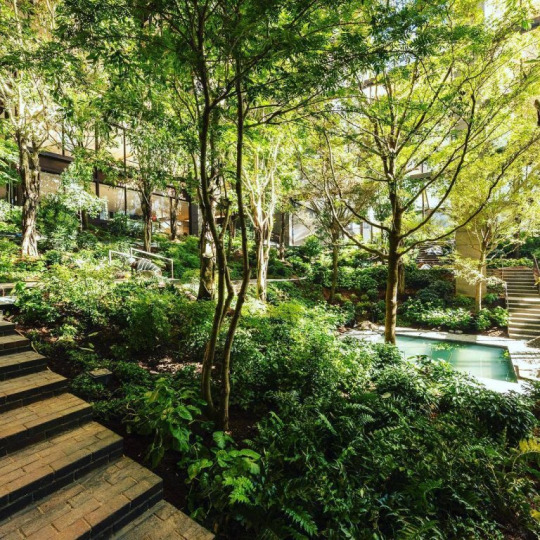
Tucked all the way at the end of 42nd Street (between 2nd Ave. and the United Nations Plaza), the Ford Foundation Center for Social Justice is a true hidden treasure of New York City. With sunlight streaming in on multiple sides, the 160-foot tall atrium holds 39 species of plants. There is also a reflecting pool, and a sensory garden with plant life you are encouraged to touch and smell. Read more here.
Where: 320 E. 43rd St.
Hours: Monday-Friday 8 a.m. – 6 p.m.https://www.instagram.com/reel/ChcXIbcAbpA/embed/?cr=1&v=14&wp=540&rd=https%3A%2F%2Fsecretnyc.co&rp=%2Fextraordinary-places-you-wont-believe-are-in-new-york-city%2F#%7B%22ci%22%3A0%2C%22os%22%3A4699.899999999907%2C%22ls%22%3A3474.899999999907%2C%22le%22%3A3748.600000000093%7D
Jamaica Bay Wildlife Refuge, Queens
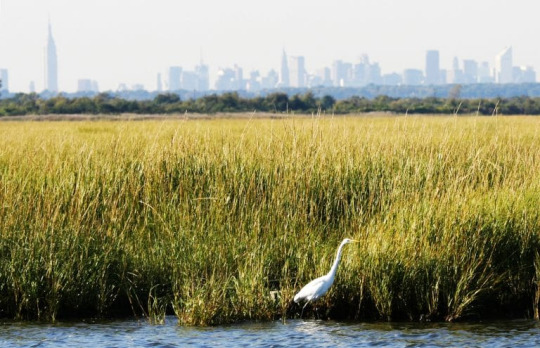
If you’re looking to be surrounded by nature instead of the concrete jungle, the Jamaica Bay Wildlife Refuge is the place for you. On over 9,155 serene acres you can hike, go bird-watching, explore turtle nesting and admire the wide variety of wildflowers, moths and butterflies.
Where: Cross Bay Blvd near Broad Channel, Queens
Hours: Open daily, 6a.m. – 9p.m.
Brooklyn Botanic Garden, Prospect Heights
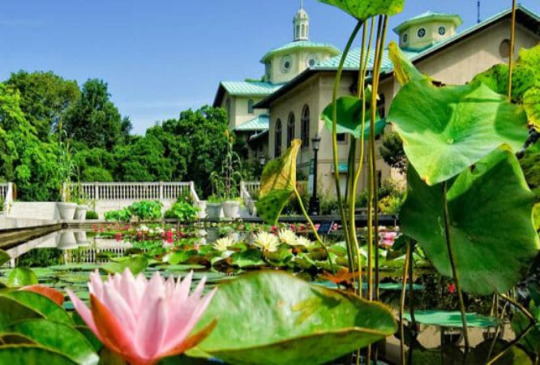
This lush oasis in the heart of Brooklyn will make you feel like you’ve been completely transported to another city. During the cherry blossom bloom in the spring, it will surely feel like a trip to Japan, but year-round it provides a natural haven for New Yorkers with varying blooms all over its very walkable grounds. Purchase tickets on their website here.
Where: 455 Flatbush Avenue, Brooklyn, NY 11225
Hours: Varies, see website for more info
But of course, Check out Central Park and the other parks, and I definitely don't just mean the parts where everyone goes!
8 notes
·
View notes
Photo

Gardens, Courtyards, and Parks: Hidden Outdoor Spaces in the NY Metro Area
Curated by our Halstead agents
Few things are as coveted in the New York City area as green spaces. In the summertime especially, we all search for nature-filled areas to escape the noise, crowds, and pace of city life. We all know of the world-famous parks and gardens the area has to offer, but what about the lesser-known green spots—the secret gardens, hidden courtyards, and easily missed parks?
No one knows the hidden gems of New York City and its surrounding towns and cities better than our agents. So we asked them to share their favorite outdoor hideaways so that we can explore them for ourselves. Take a look at the hidden outdoor spaces they recommended, and find your new favorite place to unwind.
Palma West Village, NYC
“On a charming single-block street tucked away in the West Village is a restaurant that understands how to do garden dining right,” Janet Weiner shares. “With farmhouse décor and flowers everywhere you are transported to a romantic trattoria in Italy.” At Palma, attention to detail resonates in everything.
“Faithful to generations of family recipes and traditions and using only organic ingredients, the food is sublime—don’t pass up the pasta! The garden in back, overflowing with flowers and roses, is not to be missed. Its retractable glass ceiling makes outdoor dining possible year round.”
Janet recommends booking a table in the private carriage house for an intimate dinner party, while reserving the garden for a more festive event like an engagement or birthday party. “Dining in the garden at Palma is like taking a weekend getaway in the Italian countryside without leaving New York.”
Recommended by Janet Weiner of our Village office
Half-Moon Overlook Spuyten Duyvil, The Bronx
An intimate space on Palisade Avenue in Spuyten Duyvil, Half-Moon Overlook faces west and gives you a view of where the Hudson and Harlem Rivers meet. The small park is named for Henry Hudson's ship, the Halve Maen, and it is a beautiful perch to watch the sunset from and forget you're in a big city.
Recommended by the Sanjya Tidke Team of our Riverdale office
The Maidstone East Hampton, NY
The Maidstone has cozy fireplaces and a great bar inside, but it also has a beautiful garden where you can enjoy a drink or a meal. With umbrella-covered tables, benches, and plenty of greenery dotting the area, the garden is a great place to enjoy a friend’s company or sip on drinks with a larger group.
Shaded by large trees, there is a peaceful, almost park-like atmosphere here. “The grounds are absolutely beautiful,” Ani Antreasyan says. “And as a landscape designer, it’s one of my favorite places to hang out in East Hampton.”
Recommended by Ani Antreasyan of our East Hampton office
Amster Yard Turtle Bay, NYC
Tucked behind Instituto Cervantes, the Spanish Cultural Institute, Amster Yard is a true hidden gem. Vivian Ducat goes to this courtyard refuge to work sometimes and enjoys the Victorian atmosphere, with its iron grille work, wrought-iron chairs, and beautiful greenery.
Recommended by Vivian Ducat of our Harlem office
Rowayton Community Center Courtyard Rowayton, Connecticut
The land where Rowayton Library sits has a long and interesting history. Built over 100 years ago, the building that now contains the library used to be a barn and is on the National Register of Historic Places.
Mike Barbis, who is a Commissioner for the town, shares the beauty of the barn's courtyard. It was renovated a few years ago and includes café chairs and tables where you can read or simply enjoy your surroundings. There's even a 100-year-old English Yew. On the property you can also find the dog park and the greenhouse, known as the Potting Shed.
Recommended by Mike Barbis of our Darien office
Tudor City Greens Tudor City, NYC
Two elevated spaces above 42nd Street and First Avenue offer a breath of fresh, quiet air above the maddening crowds below. The gardens are maintained by a neighborhood non-profit and boast much-needed shade, flower beds, benches, and gorgeous views.
Recommended by Madeleine Dale of our West Side office
Mount Prospect Park Prospect Heights, Brooklyn
A little-known park nestled between the Brooklyn Botanic Garden and the Central Library, Mount Prospect Park contains the second highest point in all of Brooklyn and was used as a lookout point during the Revolutionary War. The park is now frequented by locals and their dogs for early-morning playtime. It's close to Kris Sylvester's home, so he often goes there with his daughter so that she can practice riding her bicycle.
Recommended by Kris Sylvester of our Village office
West Side Community Garden Upper West Side, NYC
Amelia Gewirtz was on her way to a friend's house when she heard jazz coming from a flower-filled area on 89th Street. She had happened upon the West Side Community Garden, hidden between Amsterdam and Columbus Avenues. Since then, the serene hideaway has become Amelia's favorite hidden garden, not only because of its stunning atmosphere, but also because of the many free music and theater events that are hosted there.
Recommended by Amelia Gewirtz of our West Side office
Terrain Garden Cafe Westport, Connecticut
Terrain's greenhouse cafe has beautiful décor and seasonal menus, and there is an outdoor section as well. Enjoy a peaceful meal here surrounded by the lush greenery.
Recommended by Alison Mark of our Westport office
St. Luke's Garden West Village, NYC
A green oasis in the West Village, the garden belonging to The Church of St. Luke in the Fields is a home for flowers, berries, birds, and butterflies. This is where Bo Poulsen used to have lunch, and though it's in plain sight, it's not nearly as visited as you would think.
Recommended by Bo Poulsen of our Village office
The Elevated Acre Financial District, NYC
Take the escalator at 55 Water Street to discover an expansive urban oasis above the bustle of the Financial District. Here you will find landscaped gardens, a lawn, winding paths, a beer garden, and an amphitheater. The views are pretty incredible, too.
Recommended by Madeleine Dale of our West Side office
Paerdegat Park East Flatbush, Brooklyn
Found in a part of Brooklyn with a lack of green spaces, Paerdegat Park offers a full recreation center including basketball and handball courts, a playground, benches, and most importantly, trees.
Recommended by Wilford Nelson of our Fort Greene office
New Canaan’s Protected Lands New Canaan, Connecticut
The New Canaan Land Trust owns over 350 acres of land across the town in an effort to conserve the spaces. Included are the Bristow Bird Sanctuary, Watson-Symington Woodlands, Browne Preserve, and Silvermine Fowler Preserve. Found dotted around the town, these areas have diverse terrains and feature rivers, meadows, reservoirs, and wildlife.
Recommended by John Engel of our New Canaan office
Greenacre Park Turtle Bay, NYC
A beautiful urban green space nestled between Second and Third Avenues on 51st Street, Greenacre Park is a serene escape from the bustle of the city. It features a 25-foot-high waterfall flowing down a granite wall, a rarity in New York City. “It’s truly a hidden gem,” Ali Rubenstein says.
“Mature trees and landscaping fill the space to create a jungle-like atmosphere with tables and chairs sprinkled throughout. It’s a few blocks away from my apartment, so I frequent this tranquil oasis on the weekends in the spring and summer to enjoy my morning coffee. I always leave feeling refreshed and at peace.”
Recommended by Ali Rubenstein of our Brand Team
Liz Christy Community Garden The Bowery, NYC
The oldest community garden in New York City, this green space was established by Liz Christy and a group of “green guerrillas” that cleaned up and beautified the then vacant lot. Today, you can find a pond, wildflower habitat, weeping birch trees, vegetable gardens, a grape arbor, and more.
Recommended by Madeleine Dale of our West Side office
Columbia Manhattanville Courtyard Manhattanville, NYC
Vivian Ducat was searching for a comfortable outdoor space to relax, so she headed to Columbia University’s Manhattanville campus. She walked alongside the Jerome L. Greene Science Center and came upon a lovely courtyard with shade-providing trees and colorful chairs and benches. “A breeze off the river makes it a very pleasant place to sit,” Vivian says.
Recommended by Vivian Ducat of our Harlem office
Public Hotel Garden Lower East Side, NYC
The Public Hotel has the popular Bowery Garden on its rooftop, but for a more casual atmosphere, try the small garden directly in front of the building on Chrystie Street. The space has picnic tables for you to enjoy a meal (consider getting something from the Jean-Georges food bar inside) and have a nice respite from the city.
Recommended by Bo Poulsen of our Village office
2 notes
·
View notes
Text
Wombwell Rainbow Interviews
I am honoured and privileged that the following writers local, national and international have agreed to be interviewed by me. I gave the writers two options: an emailed list of questions or a more fluid interview via messenger.
The usual ground is covered about motivation, daily routines and work ethic, but some surprises too. Some of these poets you may know, others may be new to you. I hope you enjoy the experience as much as I do.
Christine Sloan Stoddard
is a Salvadoran-American author, artist, and the founder of Quail Bell Magazine. Her books include Belladonna Magic: Spells In The Form of Poetry And Photography (Shanti Arts), Water for the Cactus Woman (Spuyten Duyvil), Hispanic and Latino Heritage in Virginia (The History Press), and other titles. Her art and writing have appeared in Ms. Magazine, The Feminist Wire, Bustle, Cosmopolitan, Native Peoples Magazine, Yes! Magazine, Teen Vogue, The Social Justice Review, Marie Claire, and elsewhere. A graduate of VCUarts and The City College of New York-CUNY, Stoddard lives in Brooklyn with her husband and a dead cactus.
Her website is https://WorldOfChristineStoddard.com.
The Interview
1. What inspired you to write poetry?
It came out of an impulse and, now a habit, to share and tell stories. I have two younger siblings and grew up telling them stories. I wrote mini books and magazines, from storybooks to comics to fashion catalogs, and sold them to the little Stoddards for a dime, maybe a quarter for a real tome. Clearly, capitalism had already taken root—though even tiny me had no illusions about getting rich from poetry. Today I continue to write across genres and forms, but poetry is my heart’s song.
2. Who introduced you to poetry?
My mother. She was the first one to champion reading and introduce all kinds of books to me, including collections of children’s poetry. Shel Silverstein was a beloved poet in my home; I think many people of my generation (and others!) can relate to that. My mother, who is originally from El Salvador and speaks English as a second language, loves British fairy tales and American folklore, so my siblings and I read a lot of poetry in that vein. Apart from her interest in the content, I’m sure my mother was just excited to learn about Anglophone cultures. Her enthusiasm was contagious. I remember her taking U.S. citizenship classes when I was little and reading books with me to practice her English. A collection I still adore from that period is The Real Mother Goose by Blanche Fisher Wright. After all, nursery rhymes are poems! But as much as I credit my mother for infecting me with the reading bug, it was my kindergarten teacher who first encouraged me to write a poem. She sat at the computer and typed up whatever I dictated. I was hooked. Thank you, Mrs. Doud, wherever you are now.
3. How aware were you of the dominating presence of older poets?
I didn’t think of them as dominating or intimidating. I thought of them as inspiring, even magical. I knew from a young age that I wanted to possess the same spell-binding powers they had. That doesn’t mean I always maintain full confidence in my abilities. I still doubt myself, but I never underestimate the importance of hard work. Elbow grease, baby!
4. What is your daily writing routine?
I write everyday, though it’d be farfetched to call my practice a routine. My process changes day by day, depending upon what else I have to do and where I need to be. I write in various notebooks, on two different computers (not to mention public ones at libraries and wherever else), and even on my phone. As much as I like the idea of forming a ritual, I’m suspicious of cultivating one. I’m afraid it would hinder me from actually writing. My current lifestyle doesn’t allow really allow for a precious routine and I’m fine with that. AmeriCorps and journalism experience taught me to get things done. Deadlines aren’t often discussed in the poetry world, but I do make them a habit in my practice, no matter how many times I have to renegotiate and extend them. I’m always most productive during residencies, when I have “a room of my own,” but that is to be expected. Yet I don’t let less than ideal circumstances prevent me from writing at home. Otherwise, I’d spend very little time actually writing. And I want to write. Truly.
5. What motivates you to write?
This question has always been difficult to answer. Quite simply, it makes me happy, even when it causes me anguish. Trust me, I’m aware of the contradiction. I just have an unstoppable urge to reflect and imagine and express myself. I know that it brings my loved ones a certain amount of pride; those closest to me are amazingly supportive, even when my work puzzles them. And, sure, I’ve earned some recognition and money from my work, too. But my loved ones’ encouragement, awards, social media mentions, press write-ups, and checks are not why I do this. They simply sweeten my circumstances a bit. I’d still do it without any of those perks. This is the folly of every artist.
6. What is your work ethic?
I’ve been told I have an incredible work ethic, at least for when I want to finish my own creative projects. I’m deeply motivated to realize my vision and get my work out into the world. But like many writers, I’m never quite satisfied. So I keep writing and writing, as if there’s any hope of getting closer to the end of the rainbow.
7. How do the writers you read when you were young influence you today?
E.B. White, Phyllis Reynolds Naylor, Roald Dahl, Marissa Moss, Arnold Lobel, Francine Pascal (and the many Sweet Valley Twins ghostwriters!!)—I owe all of you and so many other children’s and YA authors so much. The writers I read then instilled in me the value of reading and valuing my imagination. I still think back to books I read as a child and teen, no doubt.
8. Who of today’s writers do you admire the most and why?
Julia Alvarez, Joan Didion, Jamaica Kincaid, and the dearly departed Toni Morrison and Maya Angelou are some of my favorites. Though, truth be told, I’m more of a case-by-case book fan than I am an overall author fan. I admire all of these writers for their commitment to beautiful language and telling women’s stories. I also have to give a shout-out to the Quail Bell Magazine (http://www.quailbellmagazine.com/) family. I started Quail Bell in college and am floored at the community that’s grown from it. This group of artists and writers fires me up! Even textbook introverts like me need community.
9. Why do you write, as opposed to doing anything else?
I write, but I also make films and visual art. I do some performance-based work, too. I’ve presented my work at the New York Transit Museum, the John F. Kennedy Center for the Performing Arts, Annmarie Sculpture Garden-Smithsonian affiliate, the Queens Museum, the Waveland Ground Zero Hurricane Museum, and many other venues. Often, I merge my writing and my non-writing, whatever form that may take. No matter what, it’s all done in service to stories. You can learn more about my other work at http://www.worldofchristinestoddard.com/
10. What would you say to someone who asked you “How do you become a writer?”
Read. Write. Repeat. Getting published is part of the process of getting read, but it’s not what makes you a writer. Dreaming, thinking, and then putting pen to paper or fingers to keyboard is what makes you a writer. It also helps to have a sense of humor. There are going to be rough days, so learn to crack a smile once in a while.
11. Tell me about the writing projects you have on at the moment.
I had two books come out this year! It wasn’t supposed to happen that way, but as publishing schedules changed, it became inevitable. The first book is Belladonna Magic: Spells in the Form of Poetry and Photography from Shanti Arts (https://www.shantiarts.co/uploads/files/stu/STODDARD_BELLADONNA.html) and the second is Desert Fox by the Sea (http://hootnwaddle.com/desertfox/) from Hoot ’n’ Waddle. Belladonna Magic is a collection of poetry and photography first featured in Ms. Magazine, so that alone should clue you in on the feminist nature of the collection. (Though depending upon your perception of feminist art, it will probably challenge any preconceived notions.) The other book, Desert Fox by the Sea, is a collection of short stories and poems that won a fiction competition held by Four Chambers Press in Phoenix, Arizona. Hoot ’n’ Waddle, which was started by a former Four Chambers Press editor, picked up the manuscript when Four Chambers went on hiatus. I first read from the collection at the New York City Poetry Festival in July, the same month Desert Fox by the Sea came out and I’m thrilled to have two celebrations for the book in September. The first celebration will be a reading with guest writers, followed by a meditative journaling session inspired by the works read. That will take place on September 12th at Unnameable Books in Brooklyn (https://www.pw.org/literary_events/desert_fox_by_the_sea_book_launch_meditative_journaling). The second celebration will be a reading with musical and photo accompaniment at on September 22nd (https://www.pw.org/literary_events/desert_fox_by_the_sea_book_celebration_projection_music_show) at Quimby’s Books, also in Brooklyn (because that’s where I live.)
In other news, I’m honored to have my 2018 chapbook The Tale of the Clam Ear (AngelHousePress) (https://www.angelhousepress.com/index.php?Chapbooks) reviewed in the summer 2019 issue of Arc Poetry, the poetry magazine of Canada. I really wasn’t expecting that. It’s a feel-good reminder that people still read chapbooks. My next full-length book due out is Heaven Is A Photograph, thanks to the rad folks at CLASH Books (https://www.clashbooks.com/) It’s a poetry and photography book with one continuous narrative about a young art student’s hesitation to pursue photography and how she overcomes her fears. Heaven Is A Photograph will be available for pre-order at the end of the year and come out in early 2020.
As for what I’m actually writing now? My new policy is that if it isn’t just about out the gate, it’s top-secret. Publishing is an unpredictable business and you never know which press is going to go on hiatus or fold. It’s happened to me more than once before! You can learn about smaller projects as they’re released by following Quail Bell Magazine on Facebook (https://www.facebook.com/quailbellmagazine/) I’m constantly publishing pieces there, including this recent poetry film, “Jaguar in the Cotton Field,” (https://vimeo.com/354442971) featuring a poem from my chapbook by the same title.(You can order the chapbook from Another New Calligraphy. http://www.anothernewcalligraphy.com/anc047.html)
2020 is going to be a hoot. I’m damn lucky but I also work damn hard, and I’ll be a writer until I head to the grave. I might even find a way to write from six feet under.
Wombwell Rainbow Interviews: Christine Sloan Stoddard Wombwell Rainbow Interviews I am honoured and privileged that the following writers local, national and international have agreed to be interviewed by me.
0 notes
Text

Are you an older child?
Do you enjoy learning about Science, Technology, Engineering, Art, and Math?
Are you looking for new ways to be creative?
Would you like to come to some FREE virtual programs?
Then have we got news for you!!!
Older children and their parents / guardians are invited to our new series of virtual STEAM programs! Each of these workshops will be led by the children's librarians from the Kingsbridge and Spuyten Duyvil branches.
Here are the first programs we've scheduled to kick off 2022:
Monday January 24th at 4:00PM:
Digital Music Making For Kids Ages 8-12
Monday January 31 at 4:00PM:
Graphic Design With Canva For Kids Ages 9-12
Monday February 7 at 4:00PM:
Making Comics With Pixton For Kids Ages 9-12
You can learn about all of our upcoming programs and register for them on our website [https://nypl.org/kingsbridge].
PLEASE NOTE: These programs are geared towards parents/caregivers and their children. Both the parent/caregiver and the child must be present during the program: unaccompanied adults or children will be asked to leave the program. When registering for this program, parents/caregivers should use their information.
2 notes
·
View notes
Text
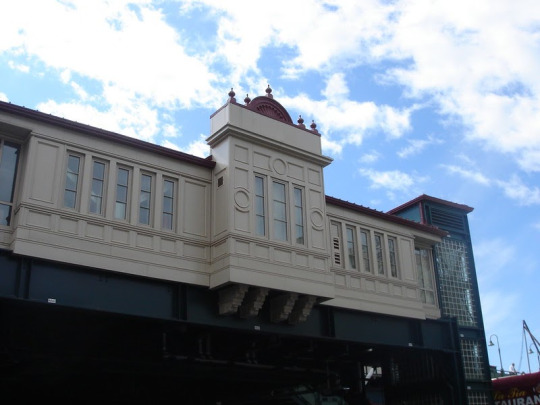
Learn More About The Kingsbridge Library, the Kingsbridge and Marble Hill Neighborhoods, and the Rest of New York City Through These Books and Online Resources!
In doing research to create our neighborhood walking/virtual tours, we used plenty of print and online resources. These resources can be super-helpful for finding information and pictures about your favorite neighborhoods, landmarks, Bishop Crook lamp posts, and more!
BOOKS:
The Manhattan Nobody Knows: An Urban Walking Guide by William B. Helmreich
Hidden Waters of New York City: A History and Guide to 101 Forgotten Lakes, Ponds, Creeks, and Streams in the Five Boroughs by Sergey Kadinsky
Broadway: A History of New York City in Thirteen Miles by Fran Leadon
The Other Islands of New York City: A History and Guide by Sharon Seitz and Stuart Miller
Wild New York: A Guide to the Wildlife, Wild Places & Natural Phenomena of New York City by Margaret Mittelbach & Michael Crewdson
Washington Heights, Inwood, and Marble Hill by James Renner
Riverdale, Kingsbridge, Spuyten Duyvil by William A. Tieck
Schools and School Days in Riverdale, Kingsbridge, Spuyten Duyvil by William A. Tieck
Northwest Bronx by Bill Twomey
The Beautiful Bronx (series) by Lloyd Ultan
The Bronx: The Ultimate Guide to New York City's Beautiful Borough by Lloyd Ultan & Shelley Olson
Forgotten New York: Views of a Lost Metropolis by Kevin Walsh
WEBSITES, BLOG POSTS, & OTHER ONLINE RESOURCES:
Kingsbridge Library Branch Page
A Short History of the Kingsbridge Library (a blog post written by one of our former colleagues!)
NYPL Digital Collections Search -- Kingsbridge
Community Profiles -- Bronx Community District 8
The Riverdale Press
King’s Bridge, Bronx
The Kingsbridge Historical Society
Kingsbridge, The Bronx (History)
History of King's Bridge in the Bronx
The Harlem Ship Canal
Kingsbridge, the Bronx Neighborhood With Royal Connections
The 231st Street Station (1920)
Marble Hill
Hooked on the Bronx, Legally Manhattan’s
Forgotten New York
The Hatching Cat: True and Unusual Animal Tales of Old New York
Digital Culture of Metropolitan New York
0 notes
Text
Wombwell Rainbow Interviews
I am honoured and privileged that the following writers local, national and international have agreed to be interviewed by me. I gave the writers two options: an emailed list of questions or a more fluid interview via messenger.
The usual ground is covered about motivation, daily routines and work ethic, but some surprises too. Some of these poets you may know, others may be new to you. I hope you enjoy the experience as much as I do.
rob mclennan
Born in Ottawa, Canada’s glorious capital city, rob mclennan currently lives in Ottawa, where he is home full-time with the two wee girls he shares with Christine McNair. The author of more than thirty trade books of poetry, fiction and non-fiction, he won the John Newlove Poetry Award in 2010, the Council for the Arts in Ottawa Mid-Career Award in 2014, and was longlisted for the CBC Poetry Prize in 2012 and 2017. In March, 2016, he was inducted into the VERSe Ottawa Hall of Honour. His most recent poetry titles include A halt, which is empty (Mansfield Press, 2019) and Life sentence, (Spuyten Duyvil, 2019). An editor and publisher, he runs above/ground press, seventeen seconds: a journal of poetry and poetics (ottawater.com/seventeenseconds), Touch the Donkey (touchthedonkey.blogspot.com) and the Ottawa poetry pdf annual ottawater (ottawater.com). He is “Interviews Editor” at Queen Mob’s Teahouse, editor of my (small press) writing day, and an editor/managing editor of many gendered mothers. He spent the 2007-8 academic year in Edmonton as writer-in-residence at the University of Alberta, and regularly posts reviews, essays, interviews and other notices at robmclennan.blogspot.com. He has a million links to books, chapbooks, interviews and other activity at his author page: robmclennanauthor.blogspot.com
The Interview
What inspired you to write poetry?
That’s a good question. I’m not entirely sure, and it’s a question I was asked by another not that long ago. I think poetry found me, and the finding, during my early high school years, solidified some of the thinking I’d already been attempting. Writing simply made sense.
It helped that I had a good social group around me during that period, many of whom were also experimenting with the beginnings of writing. We even started a small publication that our English teacher put together for us, and I contributed poems, postcard fictions and a couple of drawings.
Once my twenties began, it was the birth of my first child that really made me realize I should either pay attention to “this writing thing” properly, or simply not bother. She was born two months before I turned twenty-one, and I was soon running a home daycare full-time so I could stay home with her (taking in two other children five days a week, ten hours a day). I was writing in a coffee shop three nights a week during that period, from 7pm to midnight.
Who introduced you to poetry?
During my mid-teen years, my girlfriend (the eventual mother of my first child) was a big reader, and she introduced me to many things, including poetry and fiction, predominantly Canadian literature of the period—Leonard Cohen, Margaret Atwood, Margaret Lawrence, George Bowering, John Newlove, Alice Munro, Michael Ondaatje, Elizabeth Smart, etcetera. Through another high school peer, I became introduced to the work of Richard Brautigan, who remains my preferred American writer. I have a soft spot for him and his work I refuse to relinquish.
How aware were you of the dominating presence of older poets?
“Dominating” seems an odd word. Anyone who publishes, especially for an extended period, is going to overshadow anyone younger who hasn’t yet published. Also: I’ve known a great many ‘older poets’ who have been remarkably generous with emerging writers, many of whom might not have managed to get to where they needed to gain traction with their own work without that kind of mentoring. I, myself, spent my teens and twenties encouraged by a great number of well-established writers, including Henry Beissel, Gary Geddes, Ken Norris, Judith Fitzgerald, John Newlove, George Bowering, Bruce Whiteman, Robert Hogg, Diana Brebner, John Barton, Mark Frutkin, Barry McKinnon, Elizabeth Hay and others.
I was aware of other writers only abstractly during my teen years, with few examples. Gary Geddes and Henry Beissel lived close, and I became aware of them through high school workshops. Ralph Connor was very much on my radar, as he’d written extensively on and around my geographic area, but he existed as a historical figure, not as a contemporary one (he sold a million copies of his books in 1900, being Canada’s earliest, if not first, best-selling fiction writer). It was only once I moved from the farm to the city at nineteen that I began moving through bookstores and libraries and multiple reading series, and getting a slow sense of what was happening with writing.
By the time I was twenty-three (1993), I’d started reviewing poetry titles, which quickly emerged into what has become a lengthy engagement with reviewing poetry, fiction and non-fiction books, journals and chapbooks. I started with a column in our local weekly paper in 1994, but by the end of the decade that had fizzed out, which eventually shifted my attention online, and my blog, which began sometime in 2003. For many years, as reader, writer, editor, reading series organizer and publisher, I’ve made it my business to be aware of as much as I possibly, humanly, can.
What is your daily writing routine?
Before the birth of our wee girls (who are now three and five and a half), I was writing daily from the time I woke until late afternoon, and even kept “office hours” at a donut shop from 1994 to 2000, before shifting over to a coffee shop (once my donut shop closed) where I sat daily for fourteen further years. Once the (more recent) wee children plus our house, I moved from writing almost exclusively in public spaces to sitting at my desk in a home office. These days, I’m either with the children, or I’m at my desk. There aren’t many opportunities for much else.
I’m currently writing around their summer program schedule—three mornings a week from 9am to 12:30pm—before I collect them from the church down the street for further adventures. There are times they are willing to play quietly, whether downstairs or in the living room, which allows me some further time at my desk, but I try to be careful with that. Once September hits, our big one begins grade one, and the wee one most likely returns to her three mornings plus two full (school) days a week, which will allow me some further attention. Perhaps that might even open the possibility that I return to that “big novel” I keep promising myself I’m still working on.
What motivates you to write?
This would seem an odd question to pose to a dairy farmer: what motivates you to milk the cows? Or to a welder: what motivates you to weld? So I offer: this is what I do. I start projects to make sense of things, and to explore particular subjects, thoughts and shapes. I finish projects because I am project-oriented (and am often eager to get to whatever might come next). Perhaps it comes from being the son of a self-directed dairy farmer, but I see what I do very much as existing in a working-class ethic. I get up, I work. I keep working. Very “Alice Munro” in my Scottish-Protestant ethic.
What is your work ethic?
My work ethic is the muscle I utilize to create and complete work. It is something I struggled to establish during my twenties, and has sustained much of my writing since.
How do the writers you read when you were young influence you today?
George Bowering was a great jumping-off point for my reading and research. He remained my favourite Canadian poet for two decades or more. He is often underacknowledged in CanLit for his wide range, and enormous amount, of editorial work and critical writing. He did, it was said, more critical work on those around him than any other writer of his generation. Through him, I discovered the work of a great deal of writers, from established to emerging, from mainstream to experimental, from Canadian to international. If one thought inevitably leads to another, so, too, my reading and thinking, and Bowering, singularly, increased my awareness exponentially.
And there are multiple books and authors I continue to return to, for rejuvenation, or solace. I’m rereading Jack Spicer these days, for example. Before that, I was digging through, yet again, Rosmarie Waldrop and Norma Cole.
Who of today’s writers do you admire the most and why?
There are many! And too many to list here. But I am always excited to see new works by Lydia Davis, Lorrie Moore, Rosmarie Waldrop, George Bowering, Stuart Ross, Gil McElroy, Jason Christie, Brecken Hancock, Julie Carr, Pattie McCarthy, Erín Moure, Jack Davis, Monty Reid, Stephen Brockwell, Pearl Pirie, Amanda Earl, Stephen Collis, Sarah Manguso, Cole Swensen, Megan Kaminski, Anna Gurton-Wachter, Hailey Higdon, Shazia Hafiz Ramji, Jordan Abel, derek beaulieu, Sarah Mangold, Sandra Ridley, Hoa Nguyen, Jessica Smith, etcetera. There are so many writers doing amazing things! And there are new things to learn and relearn from every one of them. I want to experience it all. I like seeing what I haven’t before, which can often be difficult. I want to see work that challenges the way I think of writing, and thinking.
Why do you write, as opposed to doing anything else?
This is something I know I can do, and do very well. I also really enjoy it.
It makes sense to me when I tell myself that I write. I am a writer.
What would you say to someone who asked you “How do you become a writer?”
Write as much as possible. Read as much as possible. Be fearless. Employ the long game.
Be open. Engage with others attempting the same. Edit later. Don’t be afraid to fail.
Keep going. Repeat as necessary.
Tell me about the writing projects you have on at the moment.
Since January I’ve been working on a poetry manuscript titled “book of magazine verse,” which plays off Jack Spicer’s title, writing poems that aim themselves toward specific journals and presses. In hindsight, I’m realizing just how little such pointed compositions are acknowledged, and I’m enjoying seeing where the poems end up taking me. If one attempts a couple of poems for Fence magazine, for example, they are going to sound very different than, say, poems that one might send to Grain magazine, so why not play with that structure? So much contemporary literary production would be lost without the little magazine and the small and smaller presses.
I’ve also been poking at a handful of short stories, attempting to get a sense of where a new manuscript might take me, especially since completing a further manuscript of short stories last year. I don’t just want new stories to sound like an extension of what that prior book was doing. I want to see if I can do something different with the tone, and the structure. I’m still feeling it out. I’m also working on a follow-up manuscript of postcard stories, furthering a line begun with the publication of my debut collection of short short stories, The Uncertainty Principle: stories, (Ottawa ON: Chaudiere Books, 2014). I step into that manuscript every so often, but am not in any particular hurry, there.
There are numerous other projects in various states of incompleteness, which I would like to focus on, but I might have to wait until the fall before I can consider any of that. I mean, I’ve a post-mother creative non-fiction manuscript, “The Last Good Year,” that could use reworking. I’m half-through a poetry manuscript, “snow day,” currently made up of two longer prose poems (I haven’t yet decided on what the potential third section might look like). I’ve multiple unpublished manuscripts of literary essays that could use some attention, and re-shaping, for potential publication.
There is so much more that needs to be done.
Wombwell Rainbow Interviews: rob mclennan Wombwell Rainbow Interviews I am honoured and privileged that the following writers local, national and international have agreed to be interviewed by me.
0 notes